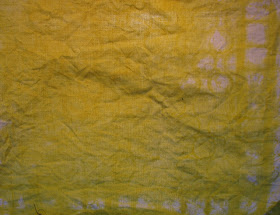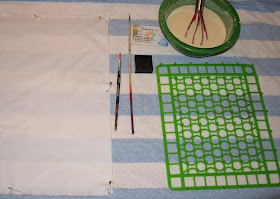FLOUR and WATER!!!! Is this not the coolest???????
I adore True batik fabric, the type that you see from Indonesia and Bali. Nothing can replace the beauty and mastery of techniques that comes with experience from the master craftsmen of that part of the world. However, I am a big fan of using simple everyday products from around the house to yield interesting and unique fabrics with ease and a good many "OH COOL" moments!!!!
So here you will find a stepped out tutorial so you can try this easy, slightly messy but oh so much fun technique!!!
(Full disclosure and giving credit where credit is due, I first saw a description of this in a recent Quilting Arts Magazine- at the time , I was not too interested. Then I saw the technqiue discussed a second time on the QUilting Arts newsletter by Pokey Bolton. She showed some really juicey green fabric` samples that she had created . Her pictures really pulled me in for a closer look. This is NOT my technique. I am simply providing pictures with discussion of my expereince witha few tips and some things that I learned along the way!! Thank you Pokey Bolton for sharing your wonderful fabric samples and for inspiring me to have a go!!!!)
So here you will find a stepped out tutorial so you can try this easy, slightly messy but oh so much fun technique!!!
(Full disclosure and giving credit where credit is due, I first saw a description of this in a recent Quilting Arts Magazine- at the time , I was not too interested. Then I saw the technqiue discussed a second time on the QUilting Arts newsletter by Pokey Bolton. She showed some really juicey green fabric` samples that she had created . Her pictures really pulled me in for a closer look. This is NOT my technique. I am simply providing pictures with discussion of my expereince witha few tips and some things that I learned along the way!! Thank you Pokey Bolton for sharing your wonderful fabric samples and for inspiring me to have a go!!!!)
1 cup of baking flour
1cup of room temp water (NOt HOT)
bowl and spoon for mixing
old credit card or other spreading tool
wooden skewer, bottle caps, grids for patterns
cotton fabric (I worked with pieces that were approximately 12x18 inches
old towel
safety pins
fabric paint or acrylic paint mixed with textile medium or thick dye
1 inch siff bristle paint brush
1). Mix flour and water with spoon till all lumps are gone.
1). Mix flour and water with spoon till all lumps are gone.
2).Pin fabric to towel in the corners and once along the middle of each side. (as flour paste dries, it will draw the fabric in and you want it to stay as flat as possible)
3).Pour a small puddle of flour paste into the center of the pinned fabric and spread it around with the credit card till it is about 1/8th of an inch thick and covers the entire piece of fabric.
3).Pour a small puddle of flour paste into the center of the pinned fabric and spread it around with the credit card till it is about 1/8th of an inch thick and covers the entire piece of fabric.
4). Allow the flour paste to settle on the fabric for about 5 minutes until you see the srface become glossy.
5). Now is the fun part!!! take your skewer and drag it throught he paste creating patterns and designs in the paste. wipe the flour paste off the tip of the skewer occassionaly to keep it clean. As the flour paste dries the lines will broaden so keep this in mind when you are creating your design.

Here you can see the glossiness that the paste takes on when it has settled. I have started to design my patterns with the skewer.

In this shot you can see that I have finished drawing on the top piece fo fabric and I am spreading more paste on the lower piece.
 I used this plastic "grid thingy" that I found at GoodWill as a stamp to press into the smoothed paste. So I was removing paste from the areas that came in contact with the grid.
I used this plastic "grid thingy" that I found at GoodWill as a stamp to press into the smoothed paste. So I was removing paste from the areas that came in contact with the grid.6). Allow the fabric with paste and pattern dry thoroughly. (I let mine dry overnight but on the next sunny day, it dried outside in the sun in about 3 hours)

Here you can see what it will look like when dry. you can see how much the dried paste draws the fabric up and why the pins are important!
 7). Wad the dried fabric up in a ball and skrunch it around in your hands. This will crack the flour paste.
7). Wad the dried fabric up in a ball and skrunch it around in your hands. This will crack the flour paste.

Here you can see what it will look like when dry. you can see how much the dried paste draws the fabric up and why the pins are important!
 7). Wad the dried fabric up in a ball and skrunch it around in your hands. This will crack the flour paste.
7). Wad the dried fabric up in a ball and skrunch it around in your hands. This will crack the flour paste.8). Smooth out the scrunched fabric and place on several sheets of newspaper to protect your work surface.
9). Spread your paint or thickened dye onto the paste covered fabric with a paintbrush and be sure that you cover all areas of white and spend a bit of time brushing the surface to work the dye/paint into all of the little cracks.
( I used full strength Setacolor paints on all of my samples)
( I used full strength Setacolor paints on all of my samples)
10). Allow the painted paste fabric to dry thoroughly.
11). When dry you will see lots of tiny little cracks in the paste surface.
12). Place the fabric pieces with dried paint and paste into a large bucket of warm water and let it soak for several minutes. the flour paste comes off fairly easily with a bit of scrubbing.
13).Iron dry to set paint or dye.
13).Iron dry to set paint or dye.
Below you see my green sample that was dyed first with green on white fabric and then overdyed with a yellow green.
The picture below shows the first dye step, before the bright green over dye.

This piece was done with a mixture of blue, fushcia and purple paints on white fabric.

I did have problems with the piece that I dyed with yellow. I did not get a thick enough layer of paste on this piece and I used dye that was too thin. The paint spread under the thin layer of paste and the pattern was lost.

the result was a yellow piece of fabric. Not to be detered, I carried on and mixed up a new batch of paste and stamped it with the plastic "grid thingy" once again. This time I painted with undiluted orange Setacolor paint.
Here you see yellow fabric covered with a good 1/8 inch thick coating of paste and then stamped with the grid to remove paste form the patterned area. Left to dry.

Here you can see the dried orange painted flour paste just before it went into the soak bucket.

TA DAAAAA!!
This was a wonderfully enjoyable adventure in surface design! I would love to do this process with kids and would be very confident that I would not have to worry about burns from hot wax or warm soy wax. No special supplies are required except some paints or dye and fun will be had by all !
If you have any questions about this surface design technique just give me a holler- youc an either ask in a comment or e-mail me privately. Now go on out and create a wonderful day for yourself!!

This piece was done with a mixture of blue, fushcia and purple paints on white fabric.

I did have problems with the piece that I dyed with yellow. I did not get a thick enough layer of paste on this piece and I used dye that was too thin. The paint spread under the thin layer of paste and the pattern was lost.

the result was a yellow piece of fabric. Not to be detered, I carried on and mixed up a new batch of paste and stamped it with the plastic "grid thingy" once again. This time I painted with undiluted orange Setacolor paint.
Here you see yellow fabric covered with a good 1/8 inch thick coating of paste and then stamped with the grid to remove paste form the patterned area. Left to dry.

Here you can see the dried orange painted flour paste just before it went into the soak bucket.

TA DAAAAA!!
This was a wonderfully enjoyable adventure in surface design! I would love to do this process with kids and would be very confident that I would not have to worry about burns from hot wax or warm soy wax. No special supplies are required except some paints or dye and fun will be had by all !
If you have any questions about this surface design technique just give me a holler- youc an either ask in a comment or e-mail me privately. Now go on out and create a wonderful day for yourself!!



Very cool! I may have to try this one....some day. :)
ReplyDeleteGreat tutorial, thanks!
ReplyDeleteGreat results Elizabeth I must try this.
ReplyDeleteOh, wow! I want to play with this! You have such beautiful results!!! Thanks for the tutorial!
ReplyDeleteI love it Elizabeth! Looks like a lot of work.
ReplyDeletedefinately an "oh cool" moment elizabeth, thanks so much for sharing your experiments so very inspiring, so glad to get in touch with you again xx
ReplyDeleteOh Oh here I go again!!!! Another project. Thanks Elizabeth your the best long distance teacher around. :-)
ReplyDeleteI don't know if i had read the original article thoroughly, because it doesn't sound familiar--but i LOVE LOVE LOVE what you've done with the technique!! adding it to my list of things to try out as soon as my new studio is set up!!
ReplyDeleteIn this kind of innovation is a perfect gift,i like it your blog so creative. :)
ReplyDeletevee
I've had similar results and felt the same excitement. You did a really good job on the step-by-step tutorial.
ReplyDeleteWow you do some interesting things with fabrics. I found your blog through Janeville's blog. I saw it said you were carving stamps and thats what I do so I came by to see yours. I didn't see any stamps yet, but I love your fabrics. Great blog! :)
ReplyDeleteI've been wanting to try this for the longest time1 You've made it look very simple so maybe I'll get it done now!! I LOVE your results!
ReplyDelete